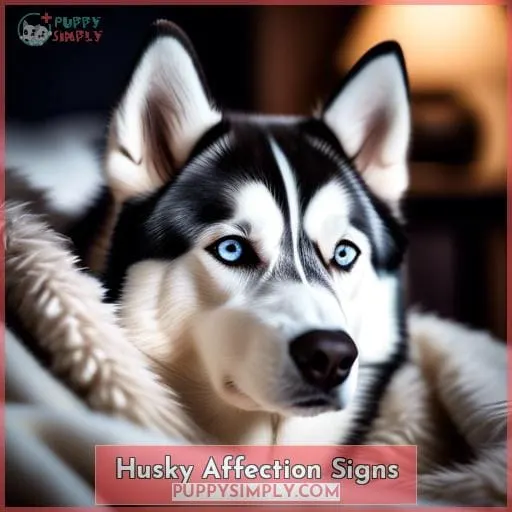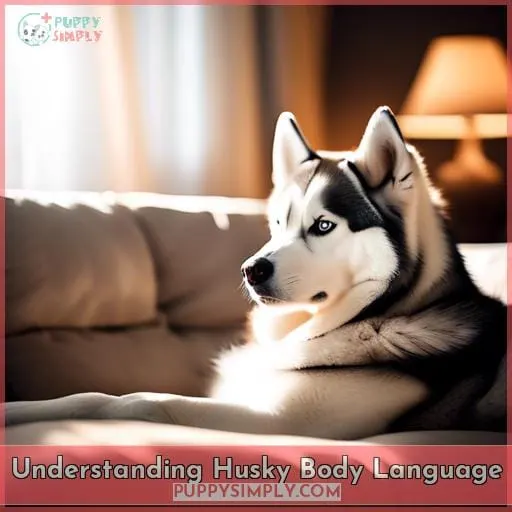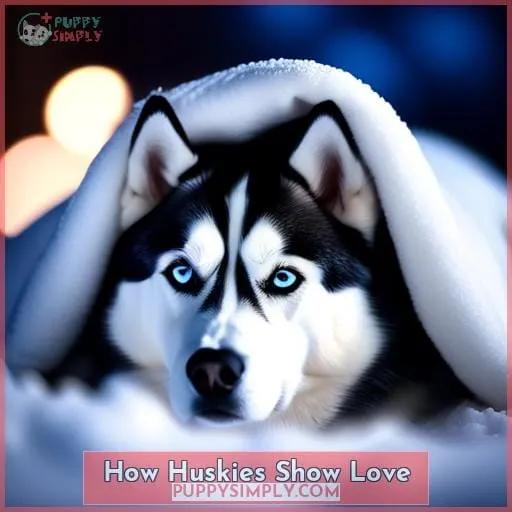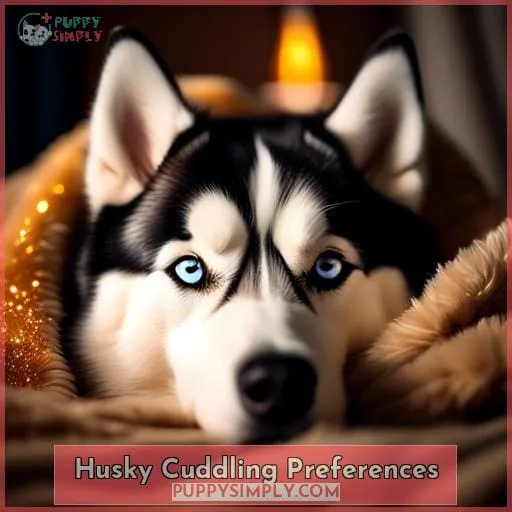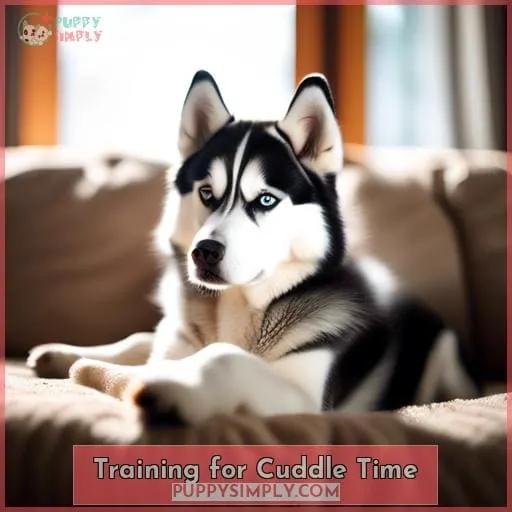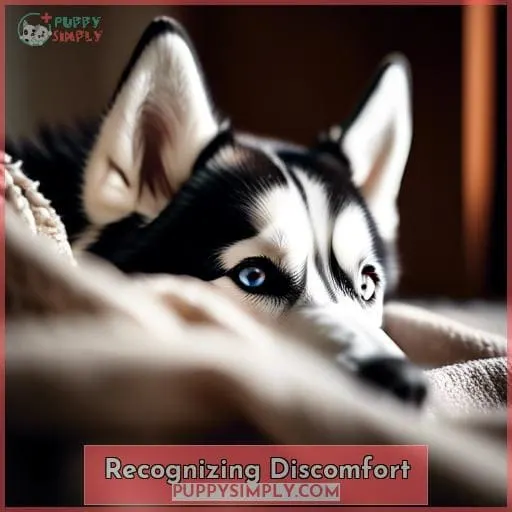This site is supported by our readers. We may earn a commission, at no cost to you, if you purchase through links.
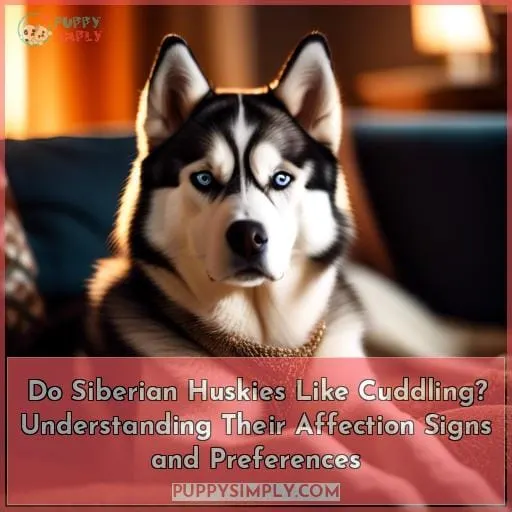 Imaginemagine a world where your fluffy companion, the
Imaginemagine a world where your fluffy companion, the
Siberian Husky, not only races through snow but also craves your warm
em brace.
While it’s easy to get lost in their gaze and independent streak, these creatures often surprise us with their affectionate side.
Do
Siberian Huskies like to cuddle?
The answer isn’t as
straightforward as a tail
wag.
H uskies, with their unique personalities, show love in various ways, from leaning against you to sharing quiet moments.
However, their desire to cuddle can vary widely.
Some may seek out cuddles, basking in the
closeness, while others value their space,
pre ferring to express their affection differently.
Understanding and respecting their individual preferences is key to nurturing a deep, meaningful bond with these spirited dogs.
Table Of Contents
- Husky Affection Signs
- Understanding Husky Body Language
- How Huskies Show Love
- Husky Cuddling Preferences
- Training for Cuddle Time
- Recognizing Discomfort
- Frequently Asked Questions (FAQs)
- Do all huskies enjoy cuddling and physical affection to the same degree?
- How can I bond with my husky if he doesn’t seem interested in cuddling very much?
- What are some alternatives to cuddling that I can try if my husky doesn’t like to be held?
- Is it okay to pick up or hold my husky if he doesn’t like cuddling?
- Should I be concerned if my husky never seeks out physical affection or contact?
- Conclusion
Husky Affection Signs
When trying to understand if your Husky likes to cuddle, pay attention to key affection signs:
- Tail wagging when excited
- Making direct eye contact to show trust
Huskies also demonstrate fondness through:
- Gentle licks as a sign of grooming love
- Leaning against you to seek attention and affection
These types of behaviors help indicate your Husky’s interest in physical closeness.
Tail Wagging and Eye Contact
When your husky wags their tail and makes eye contact with you, they’re showing signs of happiness and forming a connection.
This non-verbal communication indicates trust and contentment, markers of affection in canine body language.
Understanding these emotional cues builds your bond, helping you interpret when your furry friend desires cuddles or simply wants to revel in your presence.
Tail wags and sustained eye contact are husky signals conveying affection, bonding, and an eagerness to strengthen your lifelong friendship.
Gentle Licks and Leaning
After expressing happiness through tail wagging and eye contact, you’ll often find Huskies showing affection by gently licking and leaning against you.
These grooming rituals and affectionate gestures help build trust and strengthen your emotional connection through positive social interaction and physical contact.
Understanding their varying preferences and respecting boundaries when initiating cuddling or other affection signs is key.
Understanding Husky Body Language
When interpreting your Husky’s body language, pay attention to:
- Direct eye contact
- Vocalizations
- Tail positions
- Facial expressions
A Husky holding direct eye contact may be feeling assertive or challenging, while a relaxed facial expression indicates contentment and friendliness.
Vocalizations, tail positions, and other nonverbal signals allow you to understand your Husky’s emotions and mindset.
Direct Eye Contact and Raised Tail
As you observe your husky’s body language, take note if they make direct eye contact or raise their tail, signaling confidence or a challenging attitude.
Pay attention to these potential meanings behind assertive body language:
- Assertive gaze – Asserting dominance, confidence
- Confident posture – Excitement display, confidence demonstration
- Raised tail – Mental health, positive reinforcement
Vocalizations and Relaxed Face
You’ll know your Husky feels content when you notice their relaxed facial expressions paired with vocalizations conveying their current emotional state.
Analyzing your Husky’s facial tension and interpreting their emotive vocalizations provides insight into their mood.
Independent Huskies use sounds and facial relaxation cues to communicate their emotions, conveying a friendly and open demeanor when content.
Providing patient head rubs or neck scratches helps decipher their vocalization communication.
How Huskies Show Love
Huskies express affection through playful behavior and displays of loyalty, strengthening bonds with their trusted humans.
They also enjoy physical closeness, leaning against owners for a snuggle or offering gentle kisses.
These behaviors reinforce the loving husky-human connection.
Playfulness and Loyalty
Since huskies show affection through body language like tail wagging and leaning, you’ll also see their love in playful behavior and loyalty that reveals the strength of your bond.
Energetic and independent, huskies cherish social interaction and emotional understanding with their owners, preferring outdoor activities to strengthen bonds through playfulness and unwavering loyalty.
Snuggling and Kisses
You’ve seen how Huskies express affection through playful behavior and loyalty. Now recognize that they also show love by:
- Leaning against you for warmth
- Giving kisses
- Snuggling close on the couch
Huskies use affectionate gestures like snuggling and kisses to build trust and emotional bonds with their owners.
These comforting interactions are key bonding moments for expressing love between human and pet.
- Nuzzling into your side
- Giving gentle licks
- Curling up in your lap
Husky Cuddling Preferences
Huskies have an independent nature and varying preferences when it comes to physical affection and contact.
While some huskies enjoy and seek out frequent cuddles and close contact, others prefer more independence and personal space.
It’s important to respect each husky’s unique boundaries around affection and intimacy to strengthen your bond and avoid frustration.
Independent Nature
Despite their affection, your Husky’s autonomy makes consistent cuddling unlikely.
Balance solo adventures with together time to nurture self-reliance while preserving pack harmony.
Understand that independence doesn’t negate affection.
Create space for alone pursuits, respecting boundaries instilled by previous owners or bad experiences.
Meet cuddling needs without sacrificing freedom.
Varying Preferences and Boundaries
Some huskies enjoy affectionate snuggles, while others prefer maintaining their independence and personal space.
Respecting boundaries and understanding individual preferences is key.
Building trust through clear communication cues helps guide appropriate affection.
Setting gentle limits while responding to each husky’s unique needs can strengthen your bond.
Factors like age, temperament, and exercise needs impact desires for physical contact.
Training for Cuddle Time
When training your Husky to enjoy cuddling:
- Create a calm environment without distractions to help them feel secure.
- Use positive reinforcement, such as treats and praise, to encourage desired snuggling behaviors.
- Gradually build up the duration of cuddle time while respecting their boundaries to develop comfort with physical affection.
Creating a Calm Environment
Your Husky will appreciate having a relaxed space for introducing cuddle time.
Create a calm setting with relaxation techniques like soothing music or aromatherapy.
Provide comfortable bedding in a quiet, dimly lit area of your home.
These measures help reduce anxiety, making your Husky more receptive to affection.
Gradually build up positive associations with cuddling through this peaceful environment.
Positive Reinforcement
One way you’ll encourage cuddling is by using treats or rewards to positively reinforce desired snuggling behaviors.
- Encouraging comfort by rewarding calm interactions.
- Building trust through gentle pets and praise.
- Reinforcing boundaries by redirecting unwanted contact.
- Rewarding relaxation when they choose to settle near you.
Recognizing Discomfort
It’s important to recognize signs of discomfort in your Husky when cuddling, as this indicates boundaries being overstepped.
Respecting your Husky’s personal space and not forcing affection is key to building trust and strengthening your bond.
Look for signals like tensing up, pulling away, or avoiding eye contact as cues to give them some space.
Signs of Discomfort
You must observe your Husky’s unease.
If they pull away or tense up when you attempt affection, this demonstrates their boundaries against unwanted cuddling.
Recognizing discomfort cues like moving away or muscle tension informs you to stop, respect their preferences, and try an alternative form of bonding.
Understanding and honoring their signals builds trust.
Respecting Husky’s Space
However, if your Husky shows signs of discomfort like pulling away or tensing up when you try to cuddle them, you shouldn’t force physical affection.
Respect their personal space and look for alternative ways to bond, understanding boundaries and appreciating their autonomy.
Give them comfortable distance and freedom while strengthening your bond through play or walks, respecting their personal space.
Frequently Asked Questions (FAQs)
Do all huskies enjoy cuddling and physical affection to the same degree?
No, individual Huskies have varying preferences for physical affection.
While some relish cuddles and close contact, others favor independence.
Careful observation of each dog’s unique body language is essential to discern their comfort with snuggling.
Respect every Husky’s personal boundaries.
How can I bond with my husky if he doesn’t seem interested in cuddling very much?
Engage him in activities he enjoys:
- Walks
- Playtime
- Training sessions
The shared experience will strengthen your bond.
Offer praise, treats, and affection on his terms:
- When he seeks you out
- Go at his pace
- Don’t force interactions
He’ll warm up with time as trust builds.
Patience is key.
What are some alternatives to cuddling that I can try if my husky doesn’t like to be held?
Try interacting through play:
Engage your husky with games like fetch or tug-of-war that allow for bonding while respecting their space.
Training sessions are another great way to strengthen your relationship through positive reinforcement.
Ultimately, be patient and don’t force affection. Your husky will show you in their own way if your bond is growing.
Is it okay to pick up or hold my husky if he doesn’t like cuddling?
No, it isn’t okay to pick up or hold a husky against their will.
Respect their personal space and autonomy.
Explore alternative forms of affection.
Should I be concerned if my husky never seeks out physical affection or contact?
Yes, a lack of affection could indicate an issue.
Gently attempt contact, watching their body language.
If they consistently pull away, consult a trainer to determine causes, like anxiety.
Reward any positive interactions.
Remain patient and keep trying, but don’t force contact.
Their wellbeing is the priority.
Conclusion
Whether snuggling up close or expressing affection from afar, you can nurture a meaningful bond with your Siberian husky.
Carefully observe their unique personality and preferences to understand their loving language.
Respect their space while also inviting cuddles to meet their needs.
Adapt and compromise, as all good relationships require.
Most of all, appreciate the special way your husky likes to cuddle.

